Horizontal centrifugal pumps with mechanical seal
Dragon
DRAGON plastic horizontal centrifugal pumps are high performance pumps operated by a direct-drive electric motor for fast fluid transfer and drainage with flow-rates ranging from 6 to 40 m3/h.
The special semi-opened impeller design allows continuous pumping even with dirty fluids with apparent viscosity up to 500cps. and small suspended solids.
DRAGON centrifugal pumps feature a solid pump casing and a lantern for connecting the electric motor and inspection of the mechanical seal.
The semi-opened impeller is fitted to the pump shaft that is integral with the drive shaft of the electric motor.
The shaft mechanical seal is housed at the rear of the impeller.
Operating Principle of the Centrifugal Pump
The centrifugal pump is a hydraulic pump (turbomachine) that processes the working fluid in a constant volume over time through always open channels, with typically stationary flow (thus no valves are needed inside).
When the impeller is rotated, it also imparts rotation to the fluid (kinetic energy) and a depression in the suction conduit which, along with the thrust of atmospheric pressure, sucks the liquid into the centrifugal pump.
The fluid follows a path from the center of the impeller to its periphery due to the action of centrifugal forces and passes through the channels with increasing cross-section formed by curved blades. Already in this path, part of the kinetic energy is transformed into pressure energy.
Exiting the impeller, the fluid enters the volute, which is also made with an increasing cross-section, and the remaining amount of kinetic energy is transformed into pressure energy that increases the head. The more pressure energy transferred to the fluid, and thus the pump’s head, the farther the working fluid can be sent.
The operating range of the centrifugal pump is strictly limited to its characteristic curve.
CHARACTERISTICS OF THE CENTRIFUGAL PUMP
Each centrifugal pump is associated with its own characteristic curve, which is the graphical representation of the pump’s performance.
- Sull’asse delle ascisse (asse x) è riportata la portata Q, solitamente in m3/h. Essa indica la quantità di fluido che passa in ogni sezione della pompa centrifuga in un arco di tempo definito. Questa quantità dipende dalle caratteristiche dimensionali della pompa, dal numero di giri del motore (quindi la velocità di rotazione della girante) e dalle caratteristiche del fluido (densità e viscosità in funzione della temperatura). La portata influenza tutte le prestazioni della pompa centrifuga ed è il primo parametro tecnico da prendere in considerazione.
- On the y-axis (vertical axis), the head H is indicated, usually in meters. It is calculated from the pressure difference between the outlet and the inlet of the centrifugal pump and represents how far the fluid can be pushed if it encounters resistance in its path like height, curves, or valves.
Let’s define:
- ΔZ the height difference between the downstream basin A and the upstream basin B;
- PA and PB the pressures acting respectively on the free surface of the upstream basin A and on the free surface of the upstream basin B;
- γ = specific weight of the fluid (= density of the fluid*acceleration of gravity g);
- ΣY the sum of distributed and localized losses inside the system.
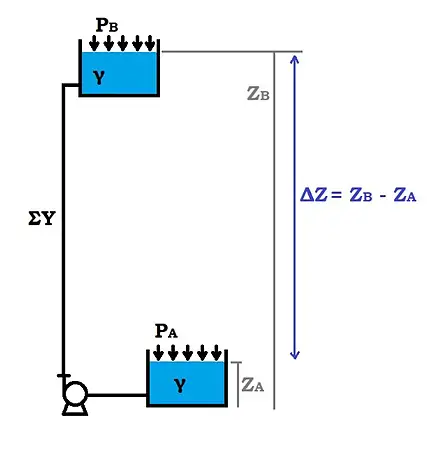
In ideal conditions, with perfectly smooth conduits, without curves, valves, or filters so 𝛴𝑌 = 0 and with 𝑃𝐴 = 𝑃𝐵 = 𝑎𝑚𝑏𝑖𝑒𝑛𝑡 𝑝𝑟𝑒𝑠𝑠𝑢𝑟𝑒, we would have 𝐻 = ΔZ, thus the centrifugal pump transfers all the energy to overcome only the height.
In reality, the pump must overcome a greater amount than just the height difference as ideal conditions can never be achieved, so the head it needs to reach is
H = ΔZ + (PB – PA)γ + Σ Y
Once the dimensions of the centrifugal pump (impeller and volute) and the rotational speed of the impeller (given by the number of motor revolutions) are established, the characteristic curve is unique and typical for each pump.
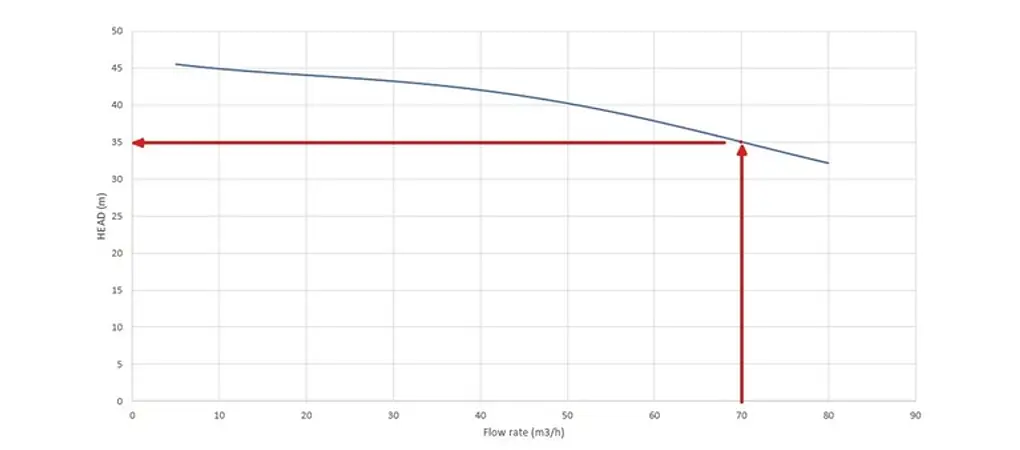
Knowing the specific weight of the fluid γ, it is also possible to calculate the theoretical power 𝑾, in Watts, required to move it:
𝑊 = 𝛾 ⋅ 𝑄 ⋅ 𝐻
The actual power 𝑾a absorbed by the motor is slightly greater as it is necessary to consider that there will always be losses due to friction and fluid dynamics within the pump itself, considered in the efficiency η. The power curve, always a function of the flow rate Q, then refers to the following formula
𝑊𝑎 = 𝑊/𝜂
It is intuitive to understand that as the flow rate increases, the required power will also increase, as shown in the graph below.
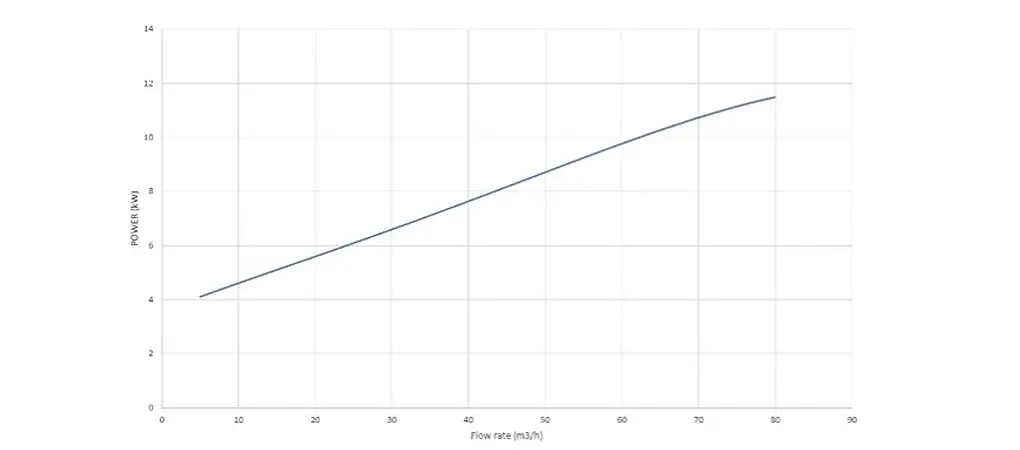
CHOOSING A CENTRIFUGAL PUMP
The centrifugal pump is suitable for applications requiring the rapid and continuous transport of a liquid. However, it is essential to evaluate all operating conditions before choosing it:
- Processed Fluid: a centrifugal pump is a high-performance but rather delicate machine. Therefore, the working liquid should have low to medium viscosity and a specific weight up to 1.9 kg/L. Higher values would excessively strain the mechanical parts and the impeller, and the functioning of the motor would be compromised due to out-of-range absorptions.
- Temperature: Fluimac centrifugal pumps can be used in a range between -5°C and +65°C if made of polypropylene, otherwise in a range between -20°C and +95°C if the centrifugal pump is made of PVDF. The important thing is that the fluid always remains in a liquid state.
- Working Conditions: each centrifugal pump is associated with a specific characteristic curve that reports the head [m] that the machine can reach given a certain flow rate [m3/h]. Knowing the conditions of one’s system before choosing a centrifugal pump prevents the risk of inadequate performance and damage to the system and the machine.
- Configuration: Fluimac offers both horizontal and vertical centrifugal pumps. The former are placed outside the extraction tank, below the fluid’s free surface level, with an axis parallel to the ground; the latter are partially submerged in the fluid and positioned with a vertical axis relative to the ground.
- Motor Power Supply: Fluimac centrifugal pumps are designed primarily for electric motor operation, but configurations with a pneumatic motor are possible. The system must be adequate and sized to ensure continuous power supply.
HOW OUR HORIZONTAL CENTRIFUGAL PUMP DRAGON IS MADE
The centrifugal pump is a hydraulic turbomachine capable of processing fluid through centrifugal effect in fixed and rotating channels that are always open, without altering the fluid’s compressibility. Hence the name centrifugal pump. The mechanical movement imparted by the motor to the impeller provides kinetic energy to the flow (acceleration in a radial direction) which is then transformed into pressure energy in the subsequent diverging channels.
The main components of a horizontal centrifugal pump with mechanical seal are:
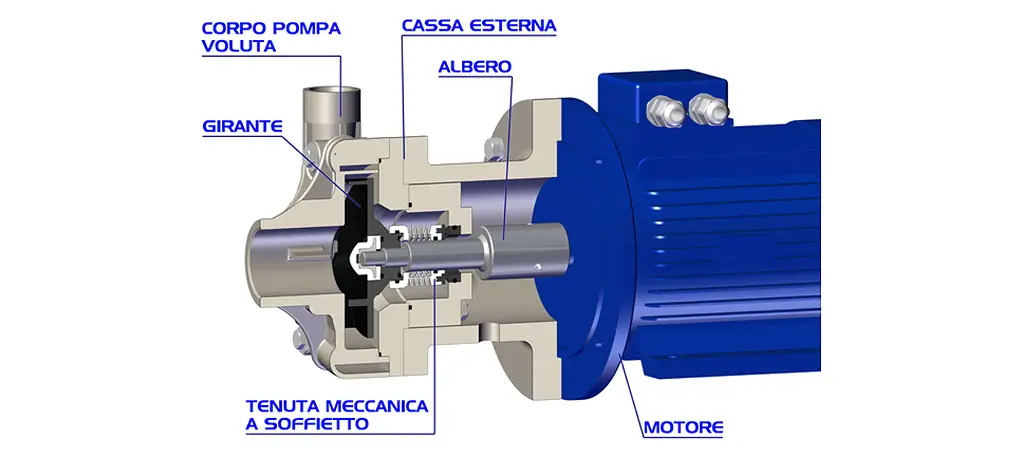
- The impeller is the main component of the centrifugal pump and the moving part with which the fluid exchanges energy. Made of plastic material reinforced with fibers (PP + FRP or PVDF + CF depending on the use of the centrifugal pump and the processed fluid), it consists of a series of curved blades forming channels that increase with the radius. The open impeller allows the passage of slightly dirty liquids, while the processing of fluids with viscosities up to 500 CPS or specific weights up to 1.9 kg/L is guaranteed by the solid and concentric movement of the impeller relative to the motor, connected via a transmission shaft.
It is possible to achieve different volumetric flows [m3/h] and heads [m] by controlling the diameter of the impeller, the curvature, the height, and the number of blades.
For each impeller, there will be a characteristic curve of the centrifugal pump, that is, what head can be achieved given a certain flow rate, the operating range, and the working point.
- The pump body or volute, snail-shaped, with an increasing section in the direction of motion, allows the axial suction of the fluid and radial discharge upwards. Besides directing the flow, it is also fundamental for the performance of the centrifugal pump: the increasing area appropriately slows down the fluid, so the kinetic energy is transformed into pressure energy.
- The mechanical bellows seal is the component that works by friction, therefore subject to greater wear, and ensures the isolation of the fluid and the hydraulic part from the outside. It consists of a mobile part that rotates together with the impeller and a fixed part locked relative to the static components of the centrifugal pump. Normally a centrifugal pump reaches rotational speeds of about 3000 rpm, so very high temperatures are reached in a very short time. It is crucial that the mechanical seal is always cooled (by the working liquid itself) and that the centrifugal pump is never operated dry, otherwise there is a risk of melting the fixed components.
- The external casing is the assembly of connecting flanges and lantern that connects the motor to the hydraulic part, keeping the latter isolated from the outside. A solid structure minimizes unwanted vibrations and friction, extending the life of the centrifugal pump.
- The motor is the part that transmits motion. In most common cases, it is a 2-pole electric motor (about 3000 rpm). Depending on the number of revolutions, it is possible to obtain different characteristic curves of the centrifugal pump.
HOW TO USE THE HORIZONTAL CENTRIFUGAL PUMP DRAGON
- Horizontal centrifugal pumps operate through a mechanical bellows seal that must always be cooled. We have designed them in such a way that this task is always performed by the working fluid, without the use of additional means, but it is important to remember that the centrifugal pump should only be started when primed, never dry, to avoid melting of components.
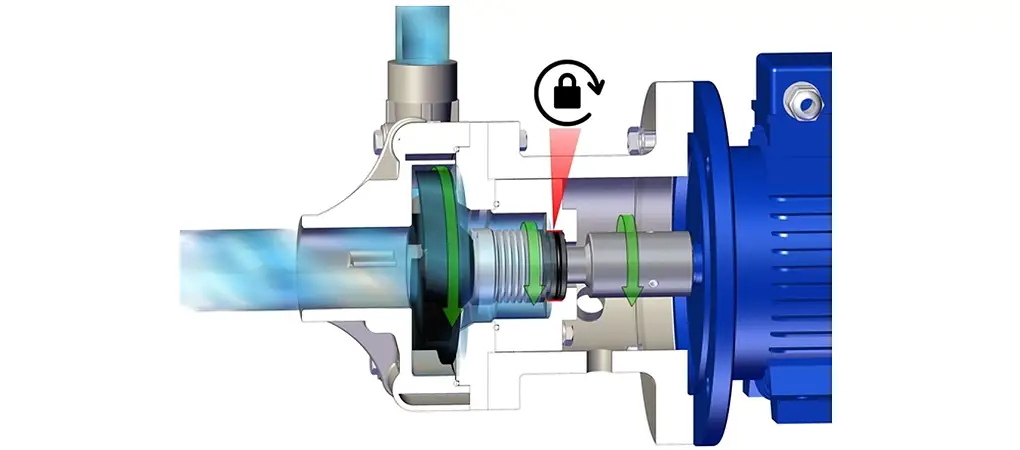
- Centrifugal pumps are ideal for applications requiring continuous flow, but given the significant speeds and forces involved, it is preferable to avoid fluids rich in solid particles or highly corrosive, which would damage the impeller and clog the flow channels.
- It is possible to move fluids up to 500 CPS or with a specific weight of up to 1.9 kg/L by increasing the motor’s power. With the same number of revolutions [rpm], increasing the motor’s power does not affect the flow rate and head of the centrifugal pump but compensates for the increased effort due to heavier liquids.
- A centrifugal pump is a very efficient but delicate machine. It is necessary to know the characteristics of the system and the working fluid to choose the right machine.
- Due to their operating principle, centrifugal pumps create a depression in suction. If the absolute pressure at the impeller inlet is lower than the vapor pressure of the working fluid, cavitation occurs (creation of bubbles of evaporated liquid and implosion on the impeller). Fluimac’s horizontal centrifugal pumps, usually positioned outside the fluid tanks, must always be installed below the liquid level so that the liquid can easily enter the pump’s suction. However, it is possible to check the maximum suction height using the NPSH curves: The pump’s NPSH (available) must always be greater than the NPSH required by the system, considering the geodetic height (height difference between the downstream tank and the pump inlet), the head losses between these two sections, and the pressure difference between the free surface pressure of the downstream tank and the vapor pressure of the liquid.
- In addition to suction conditions, it is essential to know the characteristics of the discharge pipes because they affect the calculation of the head. Before choosing a horizontal centrifugal pump, it is necessary to know the head required by the system: to the geodetic height (height difference between the downstream and upstream tanks through which to move the fluid), it is necessary to add all the head losses due to the system. We can divide the losses into two types: distributed and localized. The former depend on the fluid flow in the pipes and require knowledge of the dimensions and conditions of the pipes; the latter depend on localized factors in the system, such as curves, valves, or filters.
- Finally, it is necessary to know the working fluid. The viscosity and density also affect the calculation of the head losses and the choice of the motor’s power.
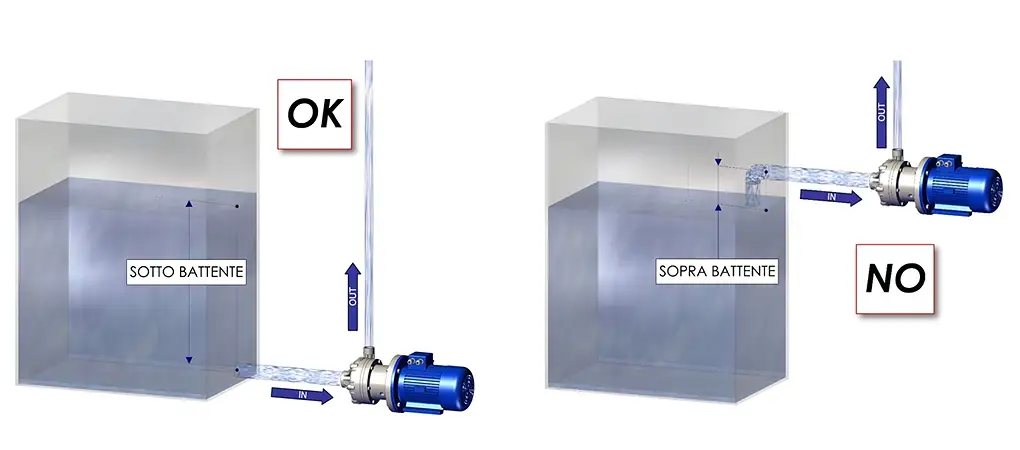
Ask for advice
Do you need support in choosing the centrifugal pump most in line with your specific fluid handling needs?
Fill out the form below and you will be contacted by our staff.
The best solutions, certified








